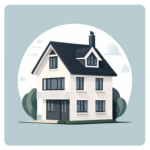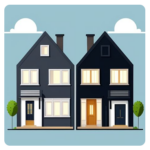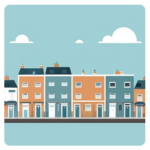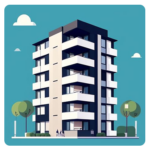

These aren’t wild swings or dramatic headlines. Darlington’s market is measured, detailed, and a little more revealing if you know where to look.
On this page, you’ll find a detailed snapshot of Darlington’s housing performance – from modest value gains to stabilised zones – all arranged to help you draw meaningful conclusions without unnecessary complexity.
House Prices > Darlington
| Year | Average Price | Transactions |
|---|---|---|
| 2025 (proj.) | £178,400 | 2,124 |
| 2024 | £175,200 | 1,722 |
| 2023 | £174,800 | 2,050 |
| 2022 | £187,200 | 2,442 |
| 2021 | £177,100 | 2,862 |
| 2020 | £169,100 | 1,891 |
| 2019 | £164,000 | 1,994 |
| 2018 | £157,700 | 1,905 |
Darlington’s property market has been simmering away quietly, with average prices drifting gently up since 2018. Growth, while unhurried, is unmistakable. Recent years have seen the market lose a little heat, but fundamentals remain sound.
The message? Darlington is not a town of wild swings. Steady, measured, and composed – this has been the dominant theme, with minor setbacks proving short-lived. For most, this spells reassurance rather than alarm.
If you are curious how much your own bricks and mortar could command right now, see our guide How Much Could You Get for Your Darlington Home Right Now?
So, what should we remember? Darlington continues to nurture slow but certain growth. Nothing hasty – and that’s no bad thing for buyers or sellers seeking a quieter corner of the North East.

Avg. Property Price: 292,100
Avg. Size of Property
1,311 sq/ft
Avg. Cost Per Sq/ft
£227 sq/ft
Total transactions
989 (since 2021)

Avg. Property Price: 166,100
Avg. Size of Property
953 sq/ft
Avg. Cost Per Sq/ft
£177 sq/ft
Total transactions
2,365 (since 2021)

Avg. Property Price: 109,400
Avg. Size of Property
910 sq/ft
Avg. Cost Per Sq/ft
£120 sq/ft
Total transactions
2,812 (since 2021)

Avg. Property Price: 98,200
Avg. Size of Property
657 sq/ft
Avg. Cost Per Sq/ft
£153 sq/ft
Total transactions
186 (since 2021)
Darlington’s property market paints a picture as varied as its riverbanks, with different home styles catering to a fascinating mix of dreams and budgets. There’s a quiet, rhythmic hum of price momentum here, not a frenzied dash. Yet, the story behind each property type is just as colourful as the Sunday morning market in the town centre.
Detached homes sit proudly on the higher branches of the property ladder, commanding both size and price. If you picture yourself gathering your family around expansive kitchen islands or gazing over sweeping lawns at sunset, these properties provide a canvas for those aspirations. The investment may be more substantial, but for those seeking room to grow or entertain, the dream of a classic detached house in Darlington feels as possible as it is timeless.
Semi-detached houses tell a different story - sociable, spacious and always in fashion. With considerable transaction numbers, it’s clear local buyers are drawn by their sturdy proportions and outdoor spaces. For growing families, or buyers making the leap from a flat, semi-detached homes blend affordability and generous living, especially in Darlington’s tree-lined, neighbourly streets. You get plenty of house for your money, but at a friendlier entry point than fully detached properties.
Terraced properties are the unsung heroes for those craving a central location or a community-spirited neighbourhood. Their enduring popularity is no fluke. Healthy transaction volumes hint that buyers see them not just as stepping stones but as stable homes and smart investments. Expect strong resale appeal, especially among first-time buyers or those with an eye for characterful, easy-to-manage spaces.
Flats serve a select portion of the market in Darlington, offering both practicality and simplicity. If you’re searching for a low-maintenance launchpad close to the town’s lively heart, these could be a shrewd option. The price per square foot is higher than most, but that’s the trade-off for compact living wrapped in convenience. We’ve noticed that they’re especially popular with solo buyers or investors looking for fuss-free assets, even if transactions are fewer.
So, what’s the summary? Detached and semi-detached homes in Darlington invite you to spread out, with room for dreams and long tables at family Sunday lunches. Terraced houses and flats offer inviting ways in for those who value location or clever simplicity. Each property type reflects a unique rhythm, shaped by local priorities and a thoughtful approach to growth.
Curious where your Darlington property fits in? Discover how value stacks up in your street.
| District | Avg Price (£) | Transactions |
|---|---|---|
| DL1 | £129,200 | 5,619 |
| DL2 | £250,700 | 3,402 |
| DL3 | £169,900 | 5,983 |
| DL5 | £83,800 | 1 |
Darlington’s property scene is lively, brimming with contrasts across its historic districts. Each area seems to be playing its own game, with house prices and transaction counts reflecting the very fabric of local life. The old railway town’s legacy blends beautifully with fresh neighbourhood ambition, creating a property mix that’s as varied as a game at Feethams on match day.
In the town centre and east (DL1), prices paint a more accessible picture, echoing a market where families and first-time buyers outnumber speculative investors. There’s a steady pulse of activity here, matching bustling street scenes and easy access to transport. It’s competitive too - buyers chasing bargains like seagulls after chips on the North Sea breeze.
Head further out to DL2 and the shift is immediate. Space, detached homes, and rural surroundings drive up average prices dramatically. This is where neighbours know your name, and heritage homes whisper stories of railway pioneers. Fewer properties change hands, but when they do, those transactions sparkle like rare finds at a jumble sale. If you’re weighing up value for money or considering prestige and peace, it’s worth seeing how your Darlington property compares.
DL3 stands as a popular middle ground. West End avenues are treasured for their leafy character, handsome architecture, and schools that attract steady, reliable family demand. Us locals see DL3 as a sweet spot - not as punchy on price as the leafier outskirts, but streets ahead in terms of activity. This is where the market moves faster than the trains on the old Stockton line.
Then there’s DL5, which is something of a curiosity with only a handful of transactions. The ultra-low price tag here would make anyone look twice, but with so little change of hands, it reflects specific circumstances rather than a general trend.
Choosing your district in Darlington is as personal as picking your seat at Blackwell Grange. Whether you’re after vibrant streets or peace and grandeur, this town’s patchwork offers places to call home for every kind of buyer.
Please remember that the stats relate strictly to pricing averages and transaction volumes across Darlington districts.
They do not reflect property size differences or cost per square foot, so some local trends might be blurred. For a closer look, head over to our blog. Thank you kindly.
| City | Avg Price (£) | Transactions |
|---|---|---|
| Newton Aycliffe | £146,700 | 2,850 |
| Shildon | £95,200 | 1,108 |
| Yarm | £270,300 | 1,899 |
| Stockton-On-Tees | £160,300 | 13,025 |
| Ferryhill | £106,700 | 1,470 |
| Bishop Auckland | £138,000 | 3,419 |
| Spennymoor | £137,700 | 2,786 |
| Billingham | £175,600 | 3,867 |
| Catterick Garrison | £150,100 | 703 |
| Northallerton | £248,400 | 2,777 |
Look just north of the River Tees and you’ll see the story of Darlington’s house prices coming alive in vivid colour. Darlington itself hits a sweet spot, with values that stay accessible, while still holding a steady lure for buy-to-let dreamers and local families seeking space. It plays in the middle ground – far from the giddy heights of Yarm, yet standing taller than neighbouring entry-level markets like Shildon and Ferryhill.
This isn’t a static, slow-moving market, either. You’ll notice the consistent churn of thousands of transactions in places like Stockton-On-Tees and Billingham. These hotspots pulse with activity, making them attractive if you’re after liquidity, quicker sales, and plenty of comparables.
Darlington’s strategy for the aspirational investor? Position yourself in the mid-range. You avoid the feverish volatility of the high-flying hotspots where bidding wars run wild, but you aren’t stranded in sleepy, stagnant markets either. Darlington strikes a careful balance between affordability, liquidity, and growth potential.
The takeaway is simple: Darlington gives investors a sturdy stepping stone. Not too hot, not too cold – just the right temperature for steady gains and ambitious plans.
Note that these comparisons report simple averages without factoring in property details.
They do not adjust for differences in property size or cost per square foot. For a closer view, head over to our blog. Thank you.
Our site uses cookies. By using this site, you agree to the Privacy Policy and Terms of Use.